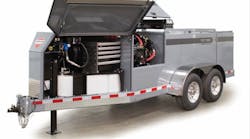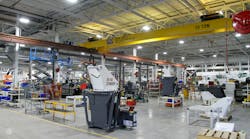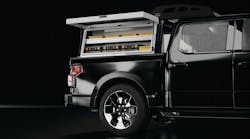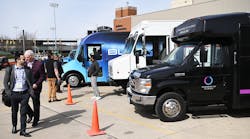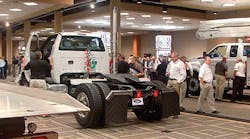FORD’S all-new 2017 Ford F-Series Super Duty features an all-new, high-strength steel frame, a segment-first, high-strength, military-grade, aluminum-alloy body, and stronger axles, springs and suspension.
The all-new Super Duty will be built at Kentucky Truck Plant, and goes on sale late next year.
The backbone is an all-new, fully boxed frame composed of more than 95 percent high-strength steel that offers up to 24 times stiffer than the previous frame – enabling the most towing and hauling capability ever delivered by Super Duty. The new truck line features heavier-duty four-wheel-drive components, driveline, axles and towing hardware.
For the first time, the Super Duty body uses high-strength, military-grade, aluminum alloy, which is more dent- and ding-resistant than the outgoing steel body and not subject to red rust corrosion.
Together, high-strength steel and high-strength aluminum alloy help reduce weight by up to 350 pounds while Ford is reinvesting additional weight savings everywhere it counts, to give customers more towing and hauling capability than ever before.
Super Duty chassis cab features an all-new, high-strength steel frame with an open-C-channel design behind the cab to enable easy aftermarket body upfit and modification.
New advanced coaching and camera technology makes conventional and gooseneck/fifth-wheel towing easier and more efficient than ever.
There are 16 segment-first new features – from LED lighting to adaptive cruise control – that assist Super Duty drivers to make driving and work situations easier and more comfortable.
As many as seven cameras help customers see more angles and monitor conditions surrounding the truck, and provide better trailering than ever before.
A center high-mounted stop lamp camera provides visibility into the cargo box, especially for easier hook-up of gooseneck/fifth-wheel trailers. A 360-degree camera system uses four digital, high-definition cameras to give the driver a bird’s-eye view surrounding Super Duty. Trailer reverse guidance provides visual cues and tips to help ease backing up a trailer. A first-ever, factory-available trailer camera can be attached to a trailer to improve visibility backing up. The new Super Duty also is available with an in-cab trailer tire pressure monitoring system to alert the driver a trailer tire drops below specified pressure.
Adaptive steering helps make towing easier—with or without a trailer. The technology reduces the amount of steering input needed to change direction at low speed, while reducing sensitivity to steering input at higher speeds.
New technology
The all-new F-Series Super Duty is available with numerous driver-assist technologies:
• SYNC 3 is Ford’s communications and entertainment system that features conversational voice recognition, an easier-to-understand graphical interface, and 8-inch touch screen
• Blind Spot Information System with trailer tow is optimized to include the length of the trailer; BLIS uses radar sensors in the tail lamps to monitor areas that may not be visible to the driver
• Lane departure warning alerts the driver through a series of steering wheel vibrations that mimic rumble strips
• Adaptive cruise control and collision warning with brake support use sensors to detect slower vehicles moving in the same direction. If another vehicle is too close, red lights flash on the windshield and a warning sound chimes. If the driver does not hit the brakes, the brake system is pre-charged to stop faster when the brake pedal is pressed.
Advanced light-emitting diode technology sheds light all around the new Super Duty, including:
• New LED sideview mirror spotlights enable illumination surrounding the truck to light up a work site or camp site
• Quad-beam LED headlamps and tail lamps
• New LED cargo box lighting.
Engine choices
The second-generation Ford-designed, Ford-built 6.7-liter Power Stroke V8 diesel engine is available for pickup trucks and chassis cabs. The 6.2-liter V8 gasoline engine comes equipped with the new TorqShift-G transmission for the F-250 pickup – allowing for improved capability.
The Super Duty chassis cab lineup offers a choice of 6.7-liter Power Stroke V8 diesel, 6.8-liter V10 gasoline or 6.2-liter V8 gasoline engines.
All three cabs – Regular Cab, SuperCab and Crew Cab – are longer and feature a new interior design, including dual compartment glove box, overhead console-mounted auxiliary switches to operate aftermarket equipment, and completely flat SuperCab and Crew Cab second-row floors that make loading large items in the cab easy. Vital controls are close at hand, with the integrated trailer brake controller switch located even closer to the driver.
The 2016 F-650/F-750 lineup became available in the spring and consists of eight models, including a dedicated tractor model. Regular, Super Cab, and Crew Cab models are offered, powered by gasoline engines and the Ford Power Stroke diesel.
The F-650/F-750 features a second-generation 6.7-liter Power Stroke V8 diesel and medium-duty six-speed TorqShift automatic transmission.
The new mesh grille helps improve airflow. Also new are redesigned fenders, aerodynamic headlamps and available PowerScope trailer tow mirrors. The mirrors feature large standard and spotter mirrors. The assembly folds and telescopes electrically.
The area behind the cab was redesigned to more easily accommodate custom work bodies, such as tow truck, dump truck and ambulance bodies.
Engineering update
Bill Chew, Vehicle Special Order (VSO) engineering supervisor, gave these updates:
• Side air curtains are standard on Transit vans, cutaways, and chassis cabs effective Job 1, 2016.
• Full-length side air curtains remain standard on all wagons.
• Required to meet FMVSS 214 (side impact protection) and future requirements for FMVSS 226 (ejection mitigation). “So if you install bulkheads, get CAD data from Ford Body Builder Advisory Service.”
• Transit seat belt retractor damage has been caused by an upfitter drilling into the retractor. “Seat belts should be cycled to ensure that they work after any vehicle modification.”
• Transit vertical CG on SRW models is 35.4” based on FMVSS 126 (electronic stability control systems). “There is potential to increase based on recent FMVSS 126 testing.”
• Transit cutaway/chassis cab rear frame bolts. “We recommend that the upfitter installs two M12 bolts and nuts to better secure frame-extension adaptors. See Transit Body Equipment Mounting Manual (BEMM) for more information.”
• Transit auxiliary fuel port kits. Gas/diesel kits include 90-degree fitting. The diesel kit also includes an auxiliary fuel pick-up straw.
• SVE Bulletin Q-239. Under-hood blunt cut wires are taped to the harness from the engine junction box.
• Battery charge protect (BCP) is now available on the E-Series with 6.8L.
• F-150: Q-231 new battery connections. Do not make a direction connection to a negative post. Battery return should be made to the grounding point (red).
• Super Duty chassis cab and transit cutaway/chassis cab reverse camera kit: Camera can be mounted to top/vertical/bottom positions. A 14-foot harness length is provided. Instructions are provided in the kit. It meets FMVSS 111 requirements.
• E-350 stripped chassis/cutaways: There is a 72-square-foot maximum frontal area. Maximum completed curb weight is not to exceed 11,500 pounds or GVWR—whichever is less.
A choice of fuels
Ford will offer the 2016 F-150 with an available gaseous-fuel prep package that enables 5.0-liter V8-powered models to run on clean, low-cost compressed natural gas or propane.
2016 F-150 trucks running on CNG or propane will be able to tow the same amount as if they were running on gasoline. Payload capability is the same as well – minus the weight of the installed CNG or propane system. Thanks to the use of advanced light-weighting materials, the 2016 F-150 with an installed CNG or propane system can haul hundreds of pounds more than a similarly equipped 2014 F-150.
CNG/propane engine prep from the factory costs $315 before the customer chooses a Ford Qualified Vehicle Modifier to supply fuel tanks, fuel lines and unique fuel injectors. Upfits run approximately $7500 to $9500 depending on fuel tank capacity.
With the addition of the 2016 F-150, Ford will offer eight commercial vehicles available from the factory with a gaseous-fuel prep option:
• 2016 F-150
• F-250 and F-350 Super Duty pickup
• F-450 and F-550 Super Duty chassis cab
• F-650 and F-750 chassis cab
• F-53 and F-59 stripped chassis
• Transit Connect van and wagon
• Transit van, wagon, cutaway and chassis cab
• E-Series cutaway and stripped chassis ♦
